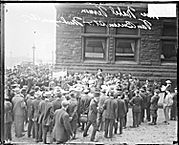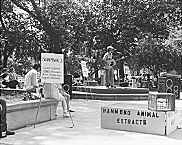| Entries |
| L |
|
Lectures and Public Speaking
|

|
Several significant events in Chicago have related closely to public lectures. The Haymarket Riot of May 4, 1886, began as a worker's rally with speeches by area anarchists. Samuel Fielden had just begun to address the crowds of striking workers and supporters when the bomb was thrown. Daniel Burnham's 1909 Plan of Chicago stemmed from Burnham's lecture for the Commercial Club of Chicago on March 27, 1897. Inspired by the speech, Commercial Club members committed at least $80,000 to the publication of Burnham's plan. Public lectures were also later used as a tool to promote the completed plan to Chicagoans.
Frederick Jackson Turner's 1893 address to the American Historical Association meeting held in conjunction with the World's Columbian Exposition ranks among the most historically significant of all speeches held in Chicago. In “The Significance of the Frontier in American History,” Turner noted an 1890 U.S. census observation that a line of westward advancement by white settlers, a “frontier,” no longer remained in the American West. Believing the existence of this frontier to have been an essential component in shaping the American character, Turner pronounced that a formative period of American life had come to an end.

|
Chicago-area clubs have sponsored many notable speakers. In the wake of the devastation caused by the Great Chicago Fire of 1871, Chicagoans launched a number of clubs designed to cater to the city's elite society. Organizations like the Fortnightly (1873), specifically aimed at women, and the Chicago Literary Club (1874) offered an array of speakers to members. The cultural efforts of such clubs brought Chicago favorable press in national periodicals.
Although public lectures no longer serve as such a popular form of recreation, Chicago universities, colleges, and educational institutions all sponsor lecture series, as do bookstores, churches, businesses, unions, and political organizations. Perhaps the largest current public-speaking venue is the Chicago Humanities Festival.
The Encyclopedia of Chicago © 2004 The Newberry Library. All Rights Reserved. Portions are copyrighted by other institutions and individuals. Additional information on copyright and permissions.